Absolutely recommended for surfers!
Free weather app “WINDY” wind speed, waves, water temperature, temperature, weather
- Map display surfing spot
- What are waves?
- What are waves, swells, swells 2, swells 3, wind waves at Windy.com?
- Windy.com Examples of waves, swells, swells 2, swells 3, wind waves
- Surfing and wave height guidelin
- Surfing and Wave Cycle Guide
- Surfing and Significant Wave Height
- Surfing and Shallow Water Effect
- Surfing- Onshore, Offshore
- Surfing- Check seawater temperature
- summary:
Map display surfing spot
When you press the surfing icon, registered surfing points all over the world and Japan will be displayed.
Weather information is displayed when you click a point.
However, PC version only.
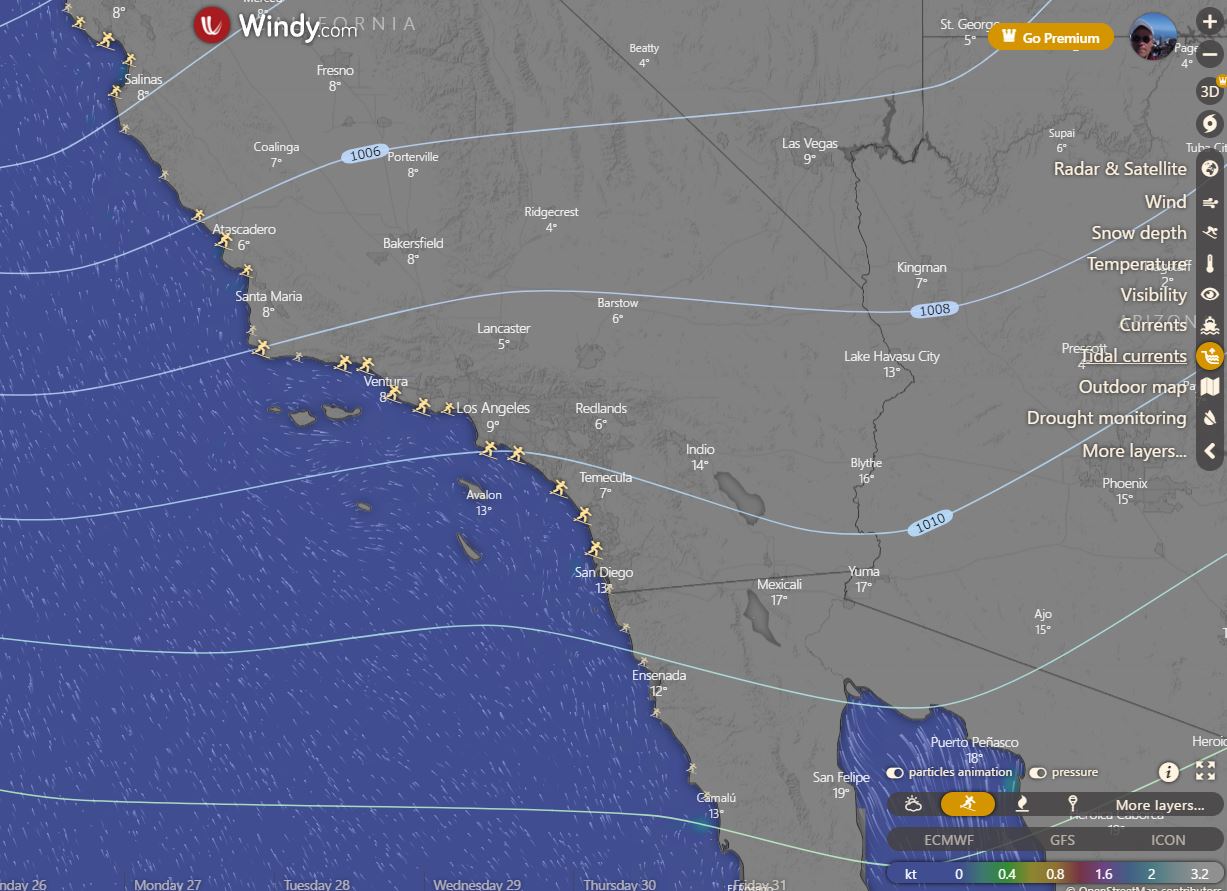
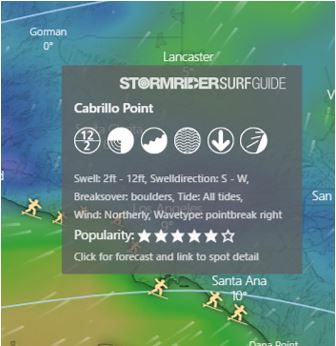
What are waves?
Waves are a combination of waves generated directly by the wind (wind waves) and gently rounded waves (swells) caused by wind waves generated in distant places.
There are two types of waves: wind waves and swells. Waves are affected by topography.
①wind waves: Waves caused by the wind
②Swells:Waves :propagated by wind-generated waves in other sea areas are called swells.
Typical examples of swell include waves caused by the aftermath of storms.
Swells have a longer period and longer wavelength than wind waves.

What are waves, swells, swells 2, swells 3, wind waves at Windy.com?
The definitions of waves, swells, swells 2, swells 3, and wind waves in the weather layer items of Windy.com are as follows.
Waves: Significant wave height and its period of all wave types combined (swell and wind waves). Close to the shoreline, the actual height is influenced by the shape of the sea bottom.
Swell1: A swell consists of wind-generated mechanical waves that are not significantly affected by the local wind at that time. They have been generated elsewhere and some time ago, usually travelling long distances.
Swell2: Secondary swell is produced also by winds far away but in other places than Swell1. It has different heights, directions and periods than Swell1.
Swell3: Another secondary swell, with different heights, directions and periods than Swell1 and Swell2. More detailed info about the swells is here.
Wind waves: Wind waves, or wind-generated waves, are surface waves that occur on the free surface of bodies of water (like oceans, seas, lakes, etc.). They result from the wind blowing over an area of water surface. Wind waves are generated by the immediate local wind – which gives them the direction. After the wind ceases to blow, wind waves are called swells.
引用先:Description of weather overlays
Windy.com Examples of waves, swells, swells 2, swells 3, wind waves
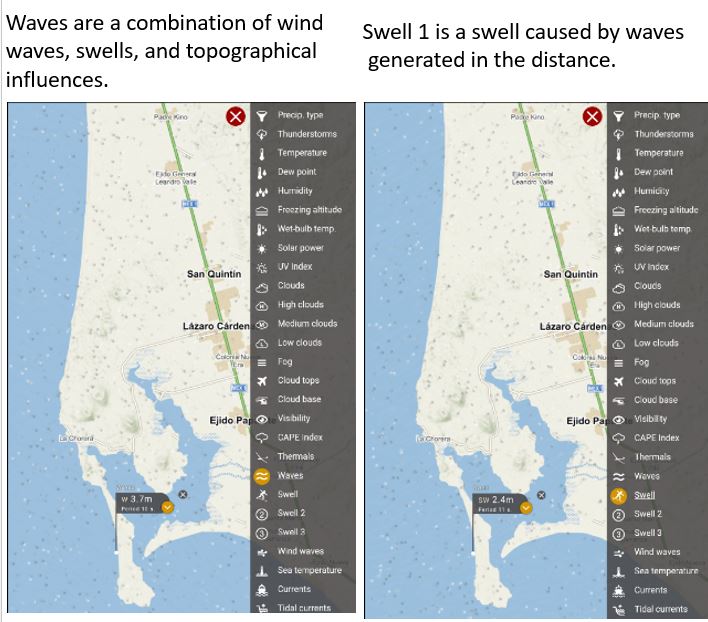
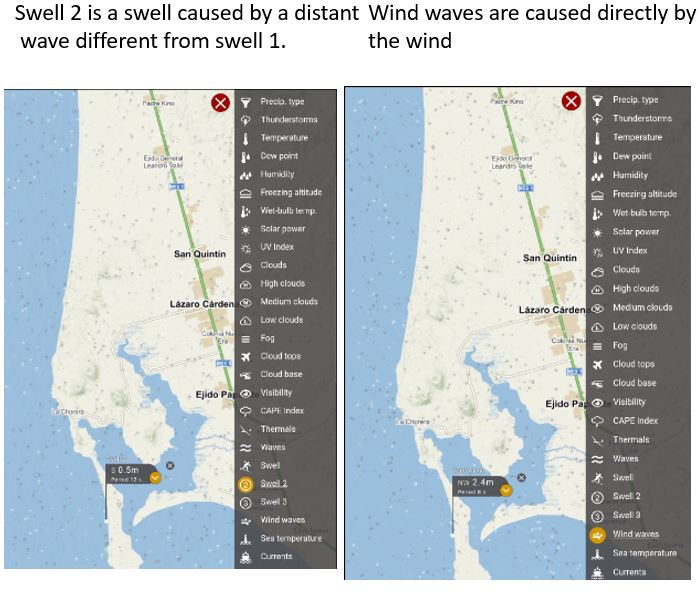
Basically, all you have to do is look at the “waves” on the layer.
Check the size and direction of the waves while being conscious of what size and angle they are entering the surf point.
We believe that the influence of swells will change depending on the environment such as the location of the surf point, direction, and topography.
Therefore, “swell 2” may be helpful at one point, and “swell 1” may be helpful at another point.
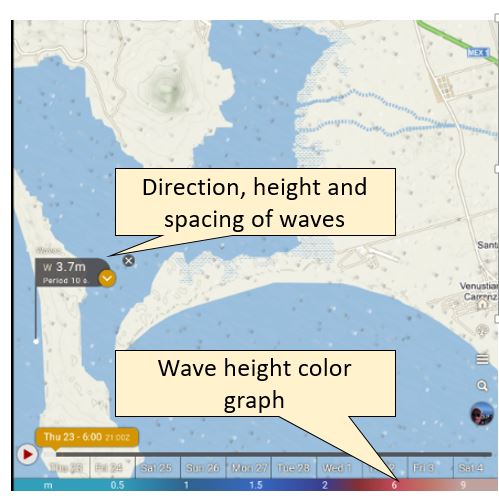
Surfing and wave height guidelin
The wave height is around 1m, which is the best size for beginners to practice, around 1.5m is a very good size for intermediate players, and around 1.8m is for advanced players.
| meters(m) | feet(ft) | Body part heigh | Surfing skill |
| 0.3048 | 0ft | ||
| 0.6096 | 1ft | Shin | beginner |
| 0.9144 | 2ft | knee to thigh | beginner |
| 1.2192 | 3ft | waist to belly | Beginner intermediate |
| 1.524 | 4ft | chest to shoulder | intermediate |
| 1.8288 | 5ft〜 | Head | Intermediate advanced |
| 3.048 | 6ft〜 | Over Head | advanced |
| 4.572 | 10ft〜 | double | advanced |
| 0.3048 | 15ft〜 | triple | advanced |
Surfing and Wave Cycle Guide
The interval between sea waves in normal times is about 3 seconds.
With this numerical value, it is not a swell but a wind wave, and the wave period is wind wave up to 6 seconds.
If the wave period is 6 seconds or more, the wave is suitable for surfing. As the wave period increases, the speed of the wave increases, so the power also increases. When the wave period exceeds 10 seconds, it is well worth a wave check, even if the wave height is low.
| Wave period | Note |
| 6 seconds or less, jumbled waves | It is a newly born weak swell that is not suitable for surfing.Areas with forecasts in this range have rough seas and strong onshore winds. |
| 7-9 seconds wind waves, uneven waves | Wind wave range.Not the best waves, but surfable enough |
| 10-12 seconds good waves | A swell generated in a place some distance away due to strong winds.There is energy that can reach far away. |
| 13-15 seconds Typhoon waves | Ground swell A swell usually caused by a storm that is fairly far away. Typhoon swells and swells that bring good waves to Indonesia are also in this range. It is a swell suitable for surfing, and when it comes to a shallow area, the energy of the wave concentrates and the wave that actually collapses tends to be larger than the height of the swell. |
Surfing and Significant Wave Height
Wave heights used in weather forecasts are usually expressed as significant wave heights.
Significant wave height is the average value of the top 1/3 of all wave heights arranged in descending order, which is close to the wave height that people intuitively perceive.
However, even with this convenient “significant wave height”, larger and smaller waves are generated.For example, 1 wave in 10 waves is 1.3 times the significant wave height, 1 wave in 100 waves is 1.6 times the significant wave height, and 1 wave in 1000 waves is twice the significant wave height.
In addition, one wave in thousands or tens of thousands of waves may be several times the significant wave height, and this is called a big wave.In this way, waves with high heights that occur stochastically, even though they are small in proportion to the whole, are called big waves. Therefore, when surfing, even if the waves are small, there is a possibility that you can meet a big wave about once in half a day.

Surfing and Shallow Water Effect
The shallow sea effect is “a phenomenon in which wave height, wave speed, and wavelength change due to the influence of the seabed when waves enter shallow sea areas (shallow sea areas), causing refraction and wave breaking.“
When a wave from offshore enters a shallow water area, if the water depth becomes shallower than 1/2 of the wavelength, the wave height, wave speed, and wavelength will change due to the influence of the seabed.
In sea areas where the water depth is 1/2 to 1/6 of the wavelength, the shallower the wave height, the lower the wave height, which is about 90% of the original wave height.
However, when the water depth becomes shallower than that, the trend reverses and the wave height rises rapidly.
Also, the wave speed tends to decrease as the water depth becomes shallower, and the wavelength tends to become shorter.
“Swell” has a longer wavelength and period than “Wind wave”, so it has the property that the wave tends to rise due to the shallow sea effect.
Therefore, swells coming from offshore can suddenly become high waves near the coast, and accidents involving waves can occur, so caution is required.
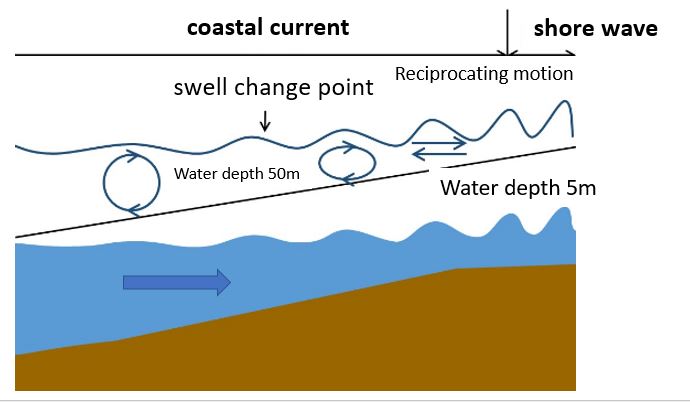
Surfing- Onshore, Offshore
If you plan to go beach Surfing, check the wind direction on Windy.com to make sure the wind direction is offshore and suitable for Surfing.
Offshore (wind that blows from the shore toward the sea)
conditions are good and the waves are good.
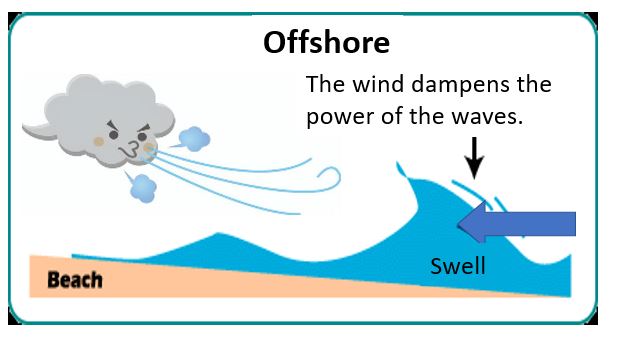
Onshore (wind that blows from the sea toward the shore) conditions It becomes a turbulent, jumbled wave.
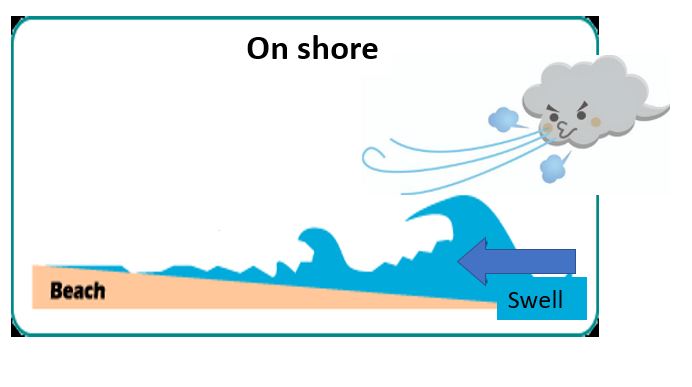
Surfing- Check seawater temperature
Estimated sea surface temperature at the actual time. For locations close to the coastline, the actual values are affected by the coastline, seabed shape, wind and waves.
Before surfing, use Windy.com to check the water temperature and choose the best wetsuit.
As the depth increases, the water temperature usually decreases.
However, near the surface of the sea, there is a layer with little change in water temperature in the depth direction, a surface mixed layer.
In the case of Japan, the seawater near the sea surface is warmed by solar radiation in the summer, and the temperature difference between the sea surface and the lower layer becomes large, so the surface mixed layer becomes thinner.
In winter, seawater is cooled on the surface of the sea, and wind blowing over the sea actively stirs the water in the upper and lower layers, forming a thick surface mixed layer.

Surfing Sea water temperature and wet suit
Seawater temperatures and suitable wetsuits for comfortable surfing are as follows.
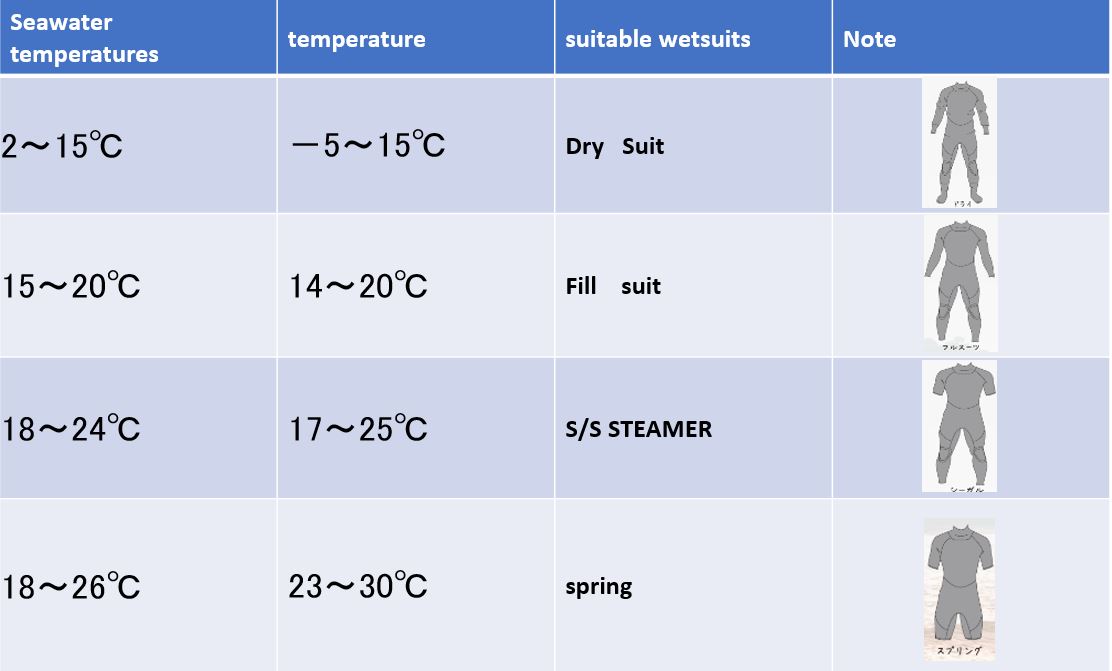
summary:
The weather forecast app Windy.com is a free app that tells you the weather conditions at a glance on a screen that visualizes weather information around the world.
However, it is prohibited to be overconfident with Windy.com alone.
Please also check the weather forecast of others App.
Windy Related article
Windy’s related article is below, please refer to it.
How to use Windy.com for sea, river, mountain weather forecast
windy.com Types and descriptions of the display on the map
Windy.com Mountain Climbing Utilization Editionきうん)Windy.com What kind of layer?
Windy.com Utilization of fishing
Windy.com Surfing Utilization Edition



コメント